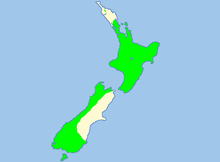Metrosideros umbellata
| Southern rātā | |
|---|---|
 |
|
| Southern rātā near Franz Josef Glacier | |
| Scientific classification | |
| Kingdom: | Plantae |
| (unranked): | Angiosperms |
| (unranked): | Eudicots |
| (unranked): | Rosids |
| Order: | Myrtales |
| Family: | Myrtaceae |
| Genus: | Metrosideros |
| Species: | M. umbellata |
| Binomial name | |
|
Metrosideros umbellata Cav. |
|
 |
|
| Distribution of M. umbellata in mainland New Zealand. Auckland Islands not shown. | |
| Synonyms | |
|
Metrosideros lucida (G. Forst) A. Rich |
|
Metrosideros lucida (G. Forst) A. Rich
Southern rātā (Metrosideros umbellata) is a tree endemic to New Zealand. It grows up to 15 metres (49 ft) or more tall with a trunk up to 1 metre (3 ft 3 in) or more in diameter. It produces masses of red flowers in summer. Unlike its relative, northern rātā, this species rarely grows as an epiphyte.
The flowers of southern rātā are scarlet, with stamens about 2 centimetres (0.79 in) long. White or yellow flowers are also known. Flowering usually occurs between December and February, but this depends on local conditions. Leaves are from 3 centimetres (1.2 in) to 6 centimetres (2.4 in) long, and are sharply pointed. The wood is hard, dense, and very strong. The bark is rough and flaky and provides an ideal stratum for the roots of epiphytic plants such as Astelia species and Freycinetia banksii (Kiekie). Southern rātā is a major source of honey on the West Coast of the South Island. Kākā, tui, and bellbirds visit rātā to take advantage of the abundant nectar.
It prefers cooler regions with high rainfall and is particularly common along the west coast of the South Island where its nectar is the main source of a locally produced rātā honey. Southern rātā is the most widespread of the New Zealand tree rātā species. It is locally present in the North Island from latitude 36° southwards, is more common in western parts of the South Island but absent from much of the east, and is common on Stewart Island (47°S) and in the Auckland Islands, where it reaches its southern limit at just over 50°S.
Although southern rātā is not regarded as threatened, it is rather uncommon in the North Island, and in certain areas it is threatened by possum browse. In the Tararua range, southern rātā populations appear to have been replaced by a population consisting of hybrids between northern and southern rātā.
Project Crimson is a charitable trust that promotes conservation of rātā as well as the related pōhutukawa.
...
Wikipedia
